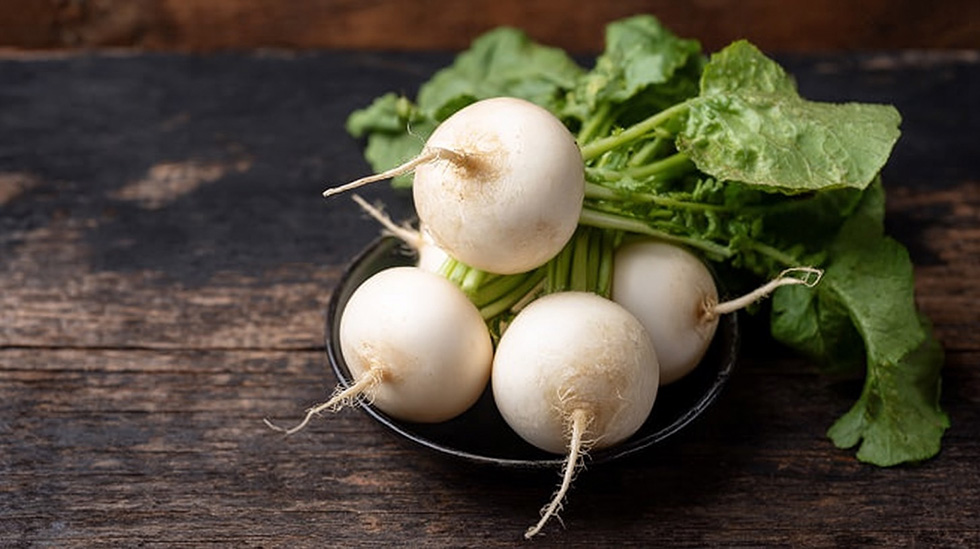White spring radish – a soft, crunchy spring favourite
White spring radishes are one of the most delicious, tamest radishes to ever grace a salad bowl. With its mellow flavour, crunchy texture and snow-white colour, it easily sneaks into hearts – and onto plates. It doesn’t sting or dominate the dish, but rather modestly enhances the flavours of the other ingredients. Let’s take a closer look at this versatile spring vegetable!

Key facts about white spring radish
White spring radishes are a particularly popular variety of common radish (Latin: Raphanus sativus var. sativus ), sometimes called “white radishes” or simply “butter radishes”. It’s not called that for nothing: when you bite into it, it melts in your mouth like butter – crunchy but not harsh, and tasting fresh and slightly sweet. Its origins go back to the Mediterranean, but it was also eaten in ancient Egypt and Rome.
How important are white spring radishes in the kitchen?
Rating: 3 out of 5
Although not as common as potatoes or carrots, white spring radishes are a real hit in spring. It’s easy to digest, versatile and particularly popular in fresh, light salads. In European kitchens, it has a seasonal place, but when the time comes, there’s hardly a dish you can’t use it to spice up.
Edible part of the plant
White spring radishes are mainly eaten with the root (the radish itself), which can be eaten raw, cooked or pickled. It is important to know that the green part of the radish is also edible and is excellent in soups, pesto or smoothies – but only while it is fresh and tender. If it’s already yellow or wilted, don’t use it. Other parts of the plant, such as the flowers or seeds, are not widely consumed, although the sprouts from the seeds are edible and healthy. There are no poisonous parts, but always wash thoroughly before use.
Health benefits
White spring radish is a vitamin bomb! 💪 It’s full of vitamin C, folic acid, potassium and antioxidants. It helps digestion, supports the immune system and has a diuretic effect. In traditional folk medicine, it has often been recommended for liver and bile problems, but it can also be beneficial for bloating and upset stomach.
Growing and season
White spring radishes are most in season in spring: from the end of March to the end of May. It is grown throughout Europe, mainly in the open air, but there are also greenhouse varieties. The largest producers include France, the Netherlands and Germany, but it is also becoming increasingly popular in Hungary. Domestic produce is available from April to May, while in the off-season months (e.g. January to February) you’ll mostly find imported produce in the shops.
How to choose a good white spring radish?
- Look for firm, smooth-skinned specimens – soft, wrinkled radishes are old or have storage defects.
- The colour should be bright white, sometimes with a slightly rosy tinge. Yellowing or brown spots indicate a lack of freshness.
- If the green is still on, it should be fresh, green and crisp – a sure sign of freshness.
How to store it at home?
- Trim the green part of the radish after buying, as it sucks the moisture from the root.
- Put the roots in a damp tea towel and place in a sealable box in the vegetable drawer of the fridge.
- It will stay fresh for up to 7-10 days!
White spring radish in the kitchens of the world
White spring radish is not only popular in our country: in Japan, for example, it is often pickled or used as a garnish for sushi. In France, it is served with butter and salt as an appetizer (brilliant!), while in Germany and Austria it is often served as a beer roll. In the USA, it is increasingly being discovered as a “crunchy snack”.
Best-known recipe: buttered baguette with radish
This French classic is simple but brilliant:
- 1 fresh baguette
- butter (preferably salty and soft)
- thinly sliced white spring radishes
- coarse sea salt
Cut the baguette in half, butter generously, top with the radish slices and sprinkle with a pinch of sea salt. Serve with cold rosé… heavenly! 🥖
Tips for use in the kitchen
- Excellent raw in salads, sandwiches or as a snack with dipping sauce.
- Grated, it can also be used in creams and buttercreams.
- When cooked, it can be used in soups and vegetable curries, although it loses its crunchiness.
- Pickled (in vinegar), it is also wonderful as a cooling snack.
What spices go with it? Lemon juice, pepper, parsley, chives and a little Roman cumin work well with it. Heavy, smoky spices like smoked paprika are best avoided as they overpower the delicate, mild flavour.
If you’re looking for something fresh and crunchy this spring that’s easy to incorporate into your daily diet, then white spring radishes are the vegetable for you! 🌱
